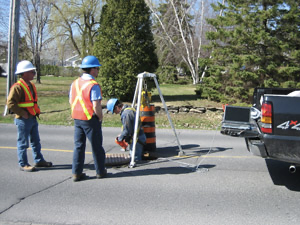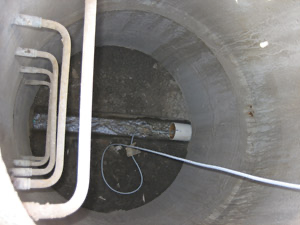No matter your industry, an accurate flow measurement has a significant impact on safety, environmental protection/compliance and your bottom line. With so many moving parts within your process, it can be a challenge to keep up with flow rate over long periods of time.
Learn how a municipality conducted a flow survey to retrieve wastewater flow data without having to entering manholes.
The Township started by video taping all of the lines in the collection system. The pipe work was found to be in good condition so significant infiltration was unlikely. Shawn realized he had to rethink the approach and find a way to leverage technology. He decided to monitor flow in high volume areas within the collection system. The Township selected Stingray Level-Velocity Loggers from Greyline Instruments because they are portable, work in partially filled pipes, and enable technicians to retrieve wastewater flow data without entering manholes.
 The I&I study of the Glen Walter Sewage Collection was conducted from May 16th to June 9th 2006. The instrument’s ultrasonic sensors were installed in 7 different manholes for periods of 3 to 5 days. To capture detailed flow information the Township set the Stingrays to take readings at 10 second intervals. To deploy each unit, a township technician selected a manhole location, attached a stainless steel bracket in the influent pipe, then mounted the sealed, ultrasonic sensor into it. The technician connected the sensor cable to the watertight electronic logging unit and hung it inside the manhole. The logger recorded the date and time, water level, velocity and temperature.
The I&I study of the Glen Walter Sewage Collection was conducted from May 16th to June 9th 2006. The instrument’s ultrasonic sensors were installed in 7 different manholes for periods of 3 to 5 days. To capture detailed flow information the Township set the Stingrays to take readings at 10 second intervals. To deploy each unit, a township technician selected a manhole location, attached a stainless steel bracket in the influent pipe, then mounted the sealed, ultrasonic sensor into it. The technician connected the sensor cable to the watertight electronic logging unit and hung it inside the manhole. The logger recorded the date and time, water level, velocity and temperature.
To conduct the study the Township recorded weather conditions on a daily basis in the Glen Walter Collection log book and the number of homes upstream of the flow monitors were also noted. When a Stingray was removed from a specific manhole, the information was transferred to Greyline Logger software and a graph was created which displayed the total flow for that specific area. At the end of the survey Shawn prepared a flow monitoring report for the Mayor and council on high volume areas within the collection system.

An average of one cubic meter a day per household was used as a guide for the amount of water used in a 24 hour time interval. Locations monitored by Stingray Level Velocity Loggers recorded flow rates 15-70% higher than statistical flows. The loggers captured spikes in flow that matched typical run times from domestic sump pumps. Because the Stingray Level-Velocity Loggers is able to monitor water temperature, Shawn also observed corresponding temperature drops matching the pump cycles. The evidence was clear: residents were connecting sump pumps to the municipal collection system.
Municipal agents went door-to-door informing residents that improper sump pump connections had been identified. They requested that any sump or eves trough discharges be disconnected from the municipal system. Shawn reported that “after the flow survey we observed a reduction in influent at the sewage treatment plant”. Since the Glen Walter study, the Greyline Stingray Level-Velocity Loggers continue to be used to measure flow in other applications in the Township of South Glengarry.
This blog was originally posted by Greyline. Read it here.
